Get Your Ultimate Guide to Common Crawl Space and Waterproofing Terms
If you’re considering renovations in your crawl space or basement, it’s important to know some commonly used terms. That way, whether you’re doing the work yourself and need to pick up some supplies at the hardware store or you want to be able to discuss the installation process with your contractor, you’ll be on solid ground (pun intended).
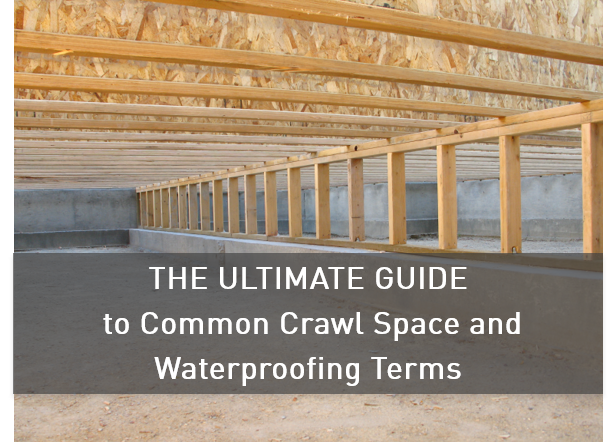
To properly install a vapor barrier in your crawl space, understanding common construction and waterproofing terms is key. | Image Source Stego® Industries LLC©.
With that in mind, I’ve compiled a list of common crawl space and basement terms that are helpful when discussing vapor barriers, as well as other waterproofing terms that are good to know. A downloadable, handy cheat-sheet provides a quick reference for questions you might have about differences between materials, tools, and terms for working in your crawl space.
Moisture Barrier Specific Terminology
Liquid Water: A grouping of hydrogen and oxygen molecules large enough to be visible to the naked eye. Liquid water will need to be addressed through waterproofing means and with products designed for waterproofing.
Water Vapor: The invisible, gaseous state of liquid water. To prevent water vapor from passing into your home, specific vapor proofing products and practices will need to be implemented. Water proofing methods will not be sufficient.
Permeance: The value of how much moisture can pass from one side of a membrane to the other. Typically, this amount is reported in perms and can be derived in this construction context via ASTM F1249 or ASTM E96.
Vapor Barrier: Any material with a water vapor permeance level of 0.01 perms or less after conditioning tests (sources: PCA and ACI). Vapor Barrier permeance of less than 0.01 perms can be achieved via a few materials, but in crawl spaces or below concrete slab, it is typically only done so with a plastic sheet or aluminum liner. Many foam insulation materials claim to be “vapor barriers”, but please check for the actual permeance rating before selecting products to use. Buyer beware: this is probably the most commonly misused term in the waterproofing industry – the term “vapor barrier” should not be used as marketing fluff – it has an actual definition. “Barrier” in this construction context does not mean no moisture passes from one side of the membrane to the other, but it is a mutually agreed upon threshold. Please see “vapor proof” below for even greater explanation.
Vapor Retarder: Any material, regardless of composition, with a permeance greater than 0.01 perms), but less than 0.10 perms (Source: ASTM E1745). By way of comparison to a “vapor barrier”, a vapor retarder allows more moisture to pass from one side of the membrane to the other.
Vapor Proof: Vapor Proof is a marketing term, but one that is typically used to convey impermeability to a problematic volume of water vapor. In reality, practically nothing is impervious to the penetration of vapor. Even a block of steel has a permeance value, it’s just a matter of how many zeros occur after the decimal point prior to the eventual 1. If you want to understand how much moisture passes from one side of any membrane to the other, find the product’s ASTM F1249 or ASTM E96 permeance value. Your goal is to keep your crawl space or concrete slab as protected from vapor sources as is reasonable and cost effective. Proper installation of the materials you choose will be vital to achieving that goal.
Tensile Strength: A value arrived at to demonstrate how much tension is acceptable until failure is achieved. Failure can be described as a fracture or tear. In other words, how much pressure can be applied until a material will tear. Ideally, the material you select for your crawl space or below-slab vapor barrier will be able to withstand a great deal of pressure before tearing, because tears would render the material’s low permeance irrelevant. In this construction context, relevant values will be reported from ASTM D882.
General Waterproofing and Moisture Protection Terminology
Waterproofing: The act of making something impervious to liquid water. This can come in the form of positive waterproofing from the outside or negative waterproofing from the inside of a structure.
Waterproof: Impervious to the penetration of liquid water. Note – this does not mean impervious to the penetration of water vapor. A system designed to be waterproof may not be vapor proof. Just because your vertical wall is waterproof, that doesn’t mean vapor can’t still migrate through the waterproofing material. In either case, if water is actively making its way into your crawlspace or basement, you can consider diverting the water to a drainage pit so it can be evacuated from the interior space.
Negative Side: Moisture protection from the inside of a home (meaning moisture has already passed through the structure wall before it’s controlled). Retroactively, this could be much less expensive than positive side moisture control for an existing home presenting leaks after it has already been constructed. Vapor barriers installed in the crawlspace or on the vertical wall of a basement are an example of negative side moisture protection.
Positive Side: Moisture protection from the outside of a home (meaning you deter moisture before it ever enters a structure). An example of positive side moisture control is waterproofing membranes applied to the exterior of a structure while it’s under construction. This kind of protection can be more expensive after the fact, after the home has already been built because digging for access to exterior perimeter walls can be problematic and labor intensive.
Closed Cell Insulation: This is the colorful foam board you can buy from your local hardware store that looks similar to Styrofoam. The dense composition of this material can combine adequate R-Values as well as low permeance values. Remember, nothing advertised as zero perm is actually zero perm. The question is whether or not the actual permeance rating is suitable for your project’s conditions. Insulation alone, due to the seams, would not be adequate as a vapor retarder/barrier in a crawl space.
Open Cell Insulation: This is the (usually pink) insulation material you can buy from your hardware store that looks like cotton candy. Because of its porous composition you will want to avoid using this material in areas with moisture present. It can wick moisture upwards and will lose its effectiveness once wet.
Thermal Load: Load on a structure created by changes in temperature, measured in watts. Effectively, the thermal load is the amount of energy (heat) that needs to be added or removed from a house to maintain a regular temperature and control moisture, a job usually performed by a house’s HVAC system. Sources that affect thermal load are the outside air temperature, indoor air temperature, underground temperature, solar radiation, and heating and cooling (HVAC) equipment.
Closed Crawl Space: A closed crawl space is one encapsulated with a liner and all air gaps to the outside are sealed, preventing exterior moisture from entering the crawl space.
Open/Vented Crawl Space: A crawl space with open vents in the perimeter walls that allow air and moisture to pass from the exterior of the home to beneath the home. Recent studies demonstrate this leads to lower indoor air quality (due primarily to the higher likelihood of mold growth) and worsened indoor energy efficiency.
Encapsulated Crawl Space: A crawl space completely sealed off to external air and moisture sources via a vapor barrier on the ground and vertical walls, spray foam filling voids in the joist band, and properly placed insulation at the perimeter walls. Also see “closed crawl space”.
Conditioned Crawl Space: An encapsulated crawl space designed to have the home’s HVAC system heating/cooling that space just as it would any other interior area of the home.
Stack/Chimney Effect: The natural movement of air in a home from low levels (basement/crawl space) to upper levels (2nd story). Natural convection draws air from down in your crawl space up into your living areas. If the air in your crawl space is moisture laden or somehow otherwise contaminated this can cause reduced air quality, musty odors, and allows gasses such as radon to infect your living space. A vapor barrier/retarder can prevent moist air and contribute to preventing other unwanted gasses from entering your living space.
Spalling: The fractures that appear in the surface of your concrete due to the stress of repeated freezing and thawing cycles. This would typically be found in exterior concrete like a driveway, but it could also be found on an exterior basement wall. If the concrete spalling becomes significant, causing larger chunks of aggregate to break away from the wall, moisture could have access points to the interior of the home.
Aggregate: Coarse particulate material used in concrete, including gravel, sand, crushed stone, and slag.
Epoxy Injection: Method to fill in cracks in concrete walls to keep liquid water (not water vapor) from entering the foundation.
French Drain: Trench filled with gravel or rock to redirect surface water. French drains can be installed on the interior or the exterior around the perimeter of a structure to carry the water away.
I hope this guide helps to prepare you for your DIY project or if you end up deciding to work with a contractor, knowing the language and being able to ask the right questions will come in handy! Check out the rest of our blog for more ways to improve the crawl space in your home.
If you are considering installing a moisture vapor barrier to protect your crawl space or basement, you can find more information and top-of-the-line barriers from Stego® Industries.

Written by Tom Marks
Tom Marks is the Business Development Project Manager with Stego Industries, LLC. He has been with Stego since 2007, serving many years as the Rocky Mountains Regional Manager. Now, his focus is geared toward vapor barrier solutions for new and existing homes as the Product Manager of the StegoHome and StegoCrawl brands. In addition, Tom serves as Sustainability Manager, overseeing Stego’s leadership in holistic product and corporate sustainability. Tom enjoys working with a wide range of project team members and customers to incorporate effective sub-slab vapor protection and create healthy, sustainable homes and buildings.
- Stego (26)
- StegoCrawl (24)
- Stego-Awareness (17)
- Case Studies (14)
- StegoCrawl-Consideration (12)
- StegoCrawl-Awareness (11)
- StegoHome (11)
- Customer Stories (9)
- Stego-Consideration (9)
- Pango (8)
- Beast (7)
- StegoHome-Awareness (6)
- How to Install (5)
- Pango-Awareness (5)
- StegoHome-Consideration (5)
- Beast-Awareness (4)
- Drago (4)
- Beast-Consideration (3)
- Pango-Consideration (3)
- Stego IQ (3)
- Drago-Awareness (2)
- Drago-Consideration (2)
- StegoCrawl-Decision (2)
Popular Posts
Stay Connected.
Enter your email below.



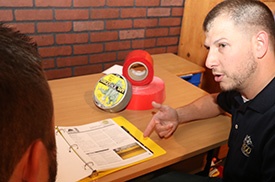

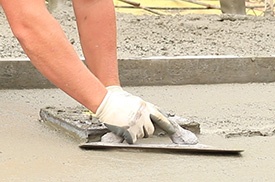
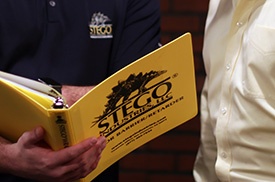

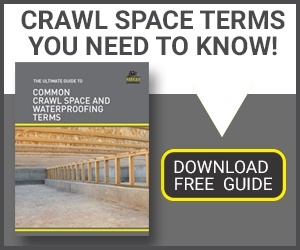


Post Comments